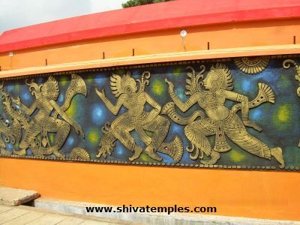Sthala Purana - Kaduveli Siddhar, a devoted follower of Lord Shiva and Parvathy, was immersed in profound meditation beneath a peepal tree when a devastating famine struck the land, resulting from insufficient rainfall and causing widespread hardship. The local ruler, believing Siddhar's rigorous penance was the source of the calamity, dispatched a Devadasi to interrupt his meditation. The Devadasi succeeded in breaking Siddhar's focus, prompting the king to inform him of the drought and his suspicions. Moved by the plight of the people, Siddhar consented to conclude his penance while continuing his devotion to Lord Shiva. Following this, the region experienced much-needed rain, revitalizing the land. In appreciation, the community organized a festival to honor Lord Shiva, with the Devadasi leading the procession through her dance. During the celebration, her anklets fell, and Siddhar, aiming to maintain the sanctity of the event, picked them up and reattached them to her feet, despite being mocked by onlookers, which caused him distress. Seeking comfort, he retreated to the sanctum and sang praises to the deity, leading to a miraculous event where the Shiva Linga exploded and fragmented. The king, recognizing his error, apologized to Siddhar, who then sang again, causing the pieces to reunite into a single Linga. To safeguard its sanctity, the king covered the Linga with a copper plate, which remains a feature of the Shiva Linga at the Makaleshwar temple in Irumbai maakalam to this day.
The Significance - There are three places in India which are suffixed with 'Makalam'. One is Ujjain in the northern part of India, and another is Ambar Maakaalam in South of River Cauvery. The third is this temple at Irumbai Maakaalam in Thondai Naadu.
Two demons, Amban and Ambasuran, were granted blessings by Lord Shiva. Fueled by their newfound powers, they sought to wed Devi Parvathy. In response, Parvathy took on the form of 'Kali' and vanquished the demons in a region known as 'Ambar', situated close to Mayiladuthurai in the southern part of India. This event led to Devi Parvathy being afflicted by Brahmahatti Dosha, prompting her to embark on a journey to this very location to engage in penance. In a subsequent era, a revered sage named Maha Kaalar, while on a spiritual pilgrimage to various Shiva Temples, consecrated a Shiva Linga at Ujjain and another at Ambar. Upon reaching this sacred site, he recognized the profound significance and divine magnificence of the deity present there. Deeply moved, the sage offered worship, and the deity came to be revered as Maha-Kaaleshwar.
Temple Layout - This unassuming Shiva temple occupies an area of one acre and features a single prakaram, lacking the traditional tower or Gopuram. Access is granted through a gateway, adjacent to which lies a sannidhi dedicated to Vinayaka. Inside the temple, a balipeetam, dwajasthambam, and Nandi are positioned in alignment with the entrance. The main deity, Maha-Kaaleshwar, is represented as a Swayambhu Linga facing east, while the goddess Kuyil-Mozhi Nayaki is oriented southward. On the western side of the prakaram, behind the sanctum, Arumukha is depicted riding a peacock alongside his consorts, Valli and Deivanai. Nearby is the sannidhi for Kaala Bhairavar, and to the left of the Ambal Sannidhi is the Natraja Sannidhi, allowing for a simultaneous view of Swamy, Ambal, and Natraja. The Navagraha Sannidhi features all planetary deities with their consorts, including Surya, who is seated on a lotus with Usha and Prathyusha. There are separate idols for Surya and Chandra, facing west in the eastern section of the prakaram. The goshta images include Vinayaka, Dakshinamurthy, Lingothbhava, Brahma, and Goddess Durga, while a sannidhi for Anjaneya is located on the northern side of the prakaram.
The walls along the prakaram are illustrated with colorful sculptures and paintings. The wall before the sanctum is cladded with a glittering copper plate and we can see the copper-plated forms of Dwarapalakas and Kaduveli Sidhdhar.
 Temple entrance
Temple entrance Altar, Flagpost and Nandhi
Altar, Flagpost and Nandhi View from outside
View from outside Kalabhairavar
Kalabhairavar Navagraha
Navagraha Illustrations on the wall
Illustrations on the wall Another view of the illustrations
Another view of the illustrations Copper plated facade
Copper plated facade Paintings
Paintings Copper plated illustration of Kaduveli Sidhdhar
Copper plated illustration of Kaduveli Sidhdhar Way to Maakaaleswarar Sannidhi
Way to Maakaaleswarar Sannidhi